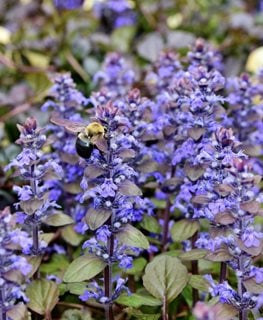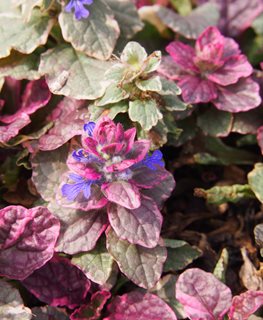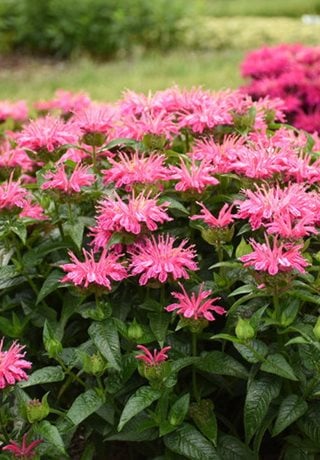HOW TO GROW & CARE FOR BUGLEWEED (AJUGA)
This versatile ground cover has many uses in the landscape
Flowering bugleweed plant. Photo by: Orest Iyzhechka / Shutterstock
Bugleweed is a common low-maintenance ground cover that is useful for quickly covering large areas. This evergreen or semi-evergreen perennial is hardy in most growing regions and is tolerant of a wide range of growing conditions, from full sun to full shade, and different soils. The small rounded foliage comes in a range of colors and patterns, with showy flower spikes that appear in spring attracting hummingbirds, butterflies, and other insect pollinators.
A member of the mint family, the most commonly grown ornamental species of bugleweed (Ajuga reptans) is native to Europe, northern Africa and western Asia, and has naturalized in the U.S. and other countries across the globe. Bugleweed has a vigorous growth habit that can be invasive in some areas (see where), so it’s important to learn how to use it in your landscape. See below for bugleweed alternatives if it is invasive in your area.
This dense, mat-forming ground cover can be used to suppress weeds and on poor sites where little else will grow. Bugleweed is versatile in beds, borders, and containers. Here’s how to grow and use bugleweed in your yard.
On this page: Basics | Planting | Care | Pictures | Frequently Asked Questions | Landscaping Ideas
On this page:
- BASICS
- PLANTING BUGLEWEED
- BUGLEWEED CARE
- BUGLEWEED VARIETIES
- FREQUENTLY ASKED QUESTIONS
- DESIGN IDEAS
BUGLEWEED BASICS
Botanical name:
Ajuga reptans and other species
Common names:
Ajuga, bugle, blue bugle, carpet bugle, common bugle, bugleherb, carpet weed, carpet bugleweed
Plant type:
Herbaceous perennial ground cover
Zones:
3-10, depending on the variety
Exposure:
Full sun to full shade
Habit:
Dense mat-forming habit; spreads through creeping rhizomes
Height/Spread:
3 to 12 inches tall, 6 to 24 inches wide, depending on the variety
Bloom time:
Late spring to early summer, with sporadic rebloom
Flowers:
Small tubular flowers resembling lobelia occur on upright spikes. Flower color is most often blue, but can also be pink or white.
Foliage:
Round or oval foliage has a crinkled texture, with a shiny or dull surface. Foliage colors can be green, burgundy, bronze, chocolate, gold, or variegated. The foliage is evergreen or semi-evergreen in all but the coldest regions.
Is bugleweed deer resistant?
Bugleweed is deer resistant due to the bitter taste of the foliage, which repels most wildlife.
HOW TO PLANT BUGLEWEED
When to plant:
Plant bugleweed during milder months in spring or fall to avoid stress from extreme heat or cold.
Where to plant:
Choose a site with partial sun to full shade and rich, well-draining soil. Some varieties are tolerant of full sun. Foliage color will be most vibrant with at least 3 to 4 hours of direct sun. Provide afternoon shade in hotter climates. Make sure there is good air circulation to discourage diseases.
How to plant:
Loosen soil in the planting area and amend with compost or other rich organic matter. Dig a hole slightly wider and deeper than the root ball. Remove plant from the nursery container and tease out roots if potbound. Place in the hole so the top of the root ball is level or slightly higher than the surrounding soil. Fill in the hole with soil, tamp down gently to remove air pockets, and water thoroughly.
Spacing:
Space plants 12 to 18 inches apart.
BUGLEWEED CARE

'Black Scallop' bugleweed. Photo: Proven Winners
Soil:
Ajuga is tolerant of a wide range of soils, but prefers rich, well drained soils with a slightly acidic pH of 4.5 to 6.5. Good drainage is essential to prevent root rot or crown rot. For containers, use a high quality all-purpose potting mix.
Amendments & fertilizer:
Bugleweed needs little or no supplemental fertilizer unless soil is poor. In early spring, apply a slow release all-purpose fertilizer according to instructions. Mulch around plants with a thin layer of compost or other organic matter to suppress weeds and retain moisture.
Watering:
Bugleweed prefers moderate moisture and is drought tolerant once established. Avoid overwatering to prevent root rot or crown rot.
Pruning:
Remove errant runners whenever they encroach into areas where they’re not wanted to keep other plants from becoming overrun. Prune out dead or damaged foliage as needed. When plants are finished blooming, shear off spent flower stalks to improve appearance. In large areas, this can be done with a lawnmower at a high setting.
Pests and diseases:
When given optimal growing conditions, bugleweed is free of most pests and diseases. Pests include aphids and root knot nematodes. In humid climates, plants are more susceptible to crown rot or powdery mildew. Overwatering or poorly drained soil can cause root rot.
BUGLEWEED VARIETIES
FREQUENTLY ASKED QUESTIONS
Is bugleweed invasive?
Ajugais considered invasive in parts of Maryland, Oregon, and West Virginia. Though it has a vigorous growth habit, it can be controlled by digging up the underground runners. Avoid planting near a turf lawn, or install a barrier to prevent bugleweed from taking over lawn areas.
Is Ajuga a good ground cover?
Ajuga is useful as a ground cover to quickly cover a slope or other large area, or when planted in challenging sites where little else will grow.
Does bugleweed come back every year?
Ajuga is a long-lived evergreen or semi-evergreen perennial that comes back reliably from year to year.
Will bugleweed choke out other plants?
Many varieties of Ajuga have a vigorous spreading plant that can displace nearby plants. Confine bugleweed to more challenging sites, or keep plants regularly pruned back.
Is bugleweed poisonous to humans?
Bugleweed is not considered toxic to humans, though it may cause digestive upset to dogs and cats if ingested. Contact your veterinarian or poison control center if your pet experiences any signs of distress.
BUGLEWEED LANDSCAPING TIPS

'Burgundy Glow' ajuga. Photo: Cha.Gheysamool / Shutterstock
For borders and landscapes:
Use bugleweed as edging, underneath trees and shrubs, as a lawn alternative, in rock gardens, mass plantings or woodland borders.
For slopes and hillsides:
Bugleweed can be massed along a slope or hillside to stem erosion.
For containers:
Plant bugleweed in containers by itself or in combination with other plants with similar growing needs.
There are many ways to use bugleweed in your landscape. Here’s how:
- Plant bugleweed alongside spring blooming bulbs such as crocus, daffodils and tulips for a colorful early season display.
- Use as a lawn substitute in challenging sites where there is no foot traffic.
- Plant bugleweed in between stepping stones for a carpet of color.
- Use as edging along a pathway, mixed border or woodland garden.
- Plant bugleweed underneath trees and shrubs. It can even be planted underneath black walnut trees where many other plants won’t grow.
- Mass along a bank or slope as a quick growing solution to stem erosion.
- Plant in a rock garden alongside alpines and other rock garden plants with similar growing needs.
- Use in difficult sites where the dense mat forming growth habit will displace weedy plants.
- Plant bugleweed in a container by itself or as a spiller element in combination with other plants with similar growing needs.
- Use around water features such as ponds or streams and combine with taller water-loving plants for a layered look.
Companion plants: Bugleweed pairs well with many trees, shrubs, perennials and annuals. Some of the best companion plants include astilbe, bleeding heart, coral bells, daffodils, ferns, forget-me-not, fothergilla, hardly geranium, holly, hydrangea, hosta, lungwort, rose, Siberian bugloss, and viola.
Alternatives to bugleweed: In regions where Ajuga is invasive, use alternative ground covers that thrive in partial shade. These include bishop’s hat, bunchberry, creeping Jenny, mazus, Siberian bugloss, spotted deadnettle, or wild ginger.
RELATED:
16 Favorite Flowering Ground Covers
20 Drought-Tolerant Plants
14 Ground Cover Plants for Sun or Shade












